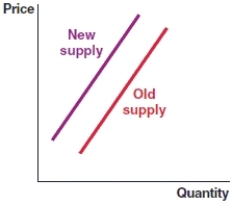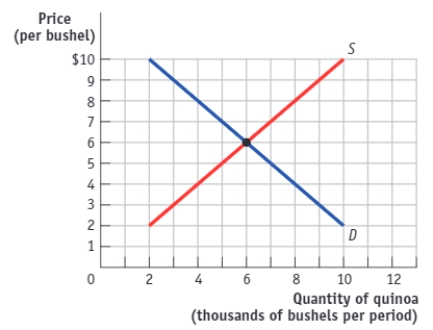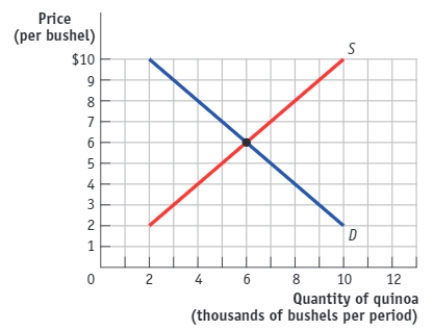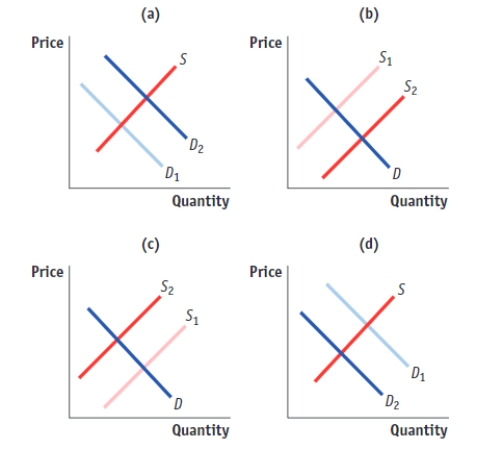A) There is a shortage of the item.
B) There is decreased demand for the item.
C) There is a surplus of the item.
D) New sellers are offering the same product.
Correct Answer

verified
Correct Answer
verified
Multiple Choice
Consider the local market for fast food hamburgers, an inferior good. If more fast food restaurants open, while consumers' incomes increase, the equilibrium price will be _____, and the equilibrium quantity will be _____.
A) higher; ambiguous
B) lower; ambiguous
C) ambiguous; higher
D) ambiguous; lower
Correct Answer

verified
Correct Answer
verified
Multiple Choice
(Figure: Shift in Supply 2) Use the figure to answer the question.
Which of the following market changes would lead to a shift of the supply curve from Old supply to New supply?

A) A rise in the price of a product that is a substitute-in-production.
B) A fall in the price of a product that is a substitute-in-production.
C) An increase in the price of a product that is a complement-in-production.
D) An increase in production efficiency.
Correct Answer

verified
Correct Answer
verified
Multiple Choice
What happens to the equilibrium price and quantity when demand decreases and at the same time supply increases, but the relative size of the shifts are not known?
A) The equilibrium price rises, and the change in the equilibrium quantity is ambiguous.
B) The equilibrium price falls, and the change in the equilibrium quantity is ambiguous.
C) The equilibrium quantity rises, and the change in the equilibrium price is ambiguous.
D) The equilibrium quantity falls, and the change in the equilibrium price is ambiguous.
Correct Answer

verified
Correct Answer
verified
Multiple Choice
The cost of sensors used in making radio frequency identification (RFID) chips falls, while a successful ad campaign makes using "tap" technology in credit card usage more fashionable. As a result, the equilibrium price of RFID chips _____, and the equilibrium quantity _____.
A) increases; increases
B) increases; may increase, decrease, or stay the same
C) may increase, decrease, or stay the same; increases
D) decreases; increases
Correct Answer

verified
Correct Answer
verified
Multiple Choice
If there is a technological advance in the production of the Amazon Echo smart speaker, you would expect to see _____ overtime.
A) a rise in its equilibrium price
B) a fall in its equilibrium price
C) no change in its equilibrium price
D) a fall in the equilibrium quantity sold
Correct Answer

verified
Correct Answer
verified
Multiple Choice
When quantity supplied exceeds quantity demanded, _____ exists.
A) a shortage
B) fixed supply
C) equilibrium
D) a surplus
Correct Answer

verified
Correct Answer
verified
Essay
You are studying the market for a particular brand of perfume. You notice that a couple of changes are happening in the market at the same time. The flower that creates the perfume scent has been affected by a disease. In addition, consumers begin to worry about the safety of the ingredients that are used in the perfume. What do you expect will happen to the equilibrium price and the equilibrium quantity? Explain your answer.
Correct Answer

verified
Correct Answer
verified
Multiple Choice
You notice that the price of notebooks falls and that the quantity of notebooks sold increases. You suspect that the _____ notebooks shifts to the _____.
A) demand for; right
B) demand for; left
C) supply of; right
D) supply of; left
Correct Answer

verified
Correct Answer
verified
Multiple Choice
(Figure: The Demand and Supply of Quinoa) Use Figure: The Demand and Supply of Quinoa. If there is an increase in demand of 2,000 bushels per period at each price, the equilibrium price and quantity will be _____ and _____ bushels per period, respectively. 
A) $5; 5,000
B) $6; 7,000
C) $7; 7,000
D) $8; 8,000
Correct Answer

verified
Correct Answer
verified
Multiple Choice
A hurricane is expected to hit the Carolinas. Why might the prices of batteries, candles, and bottled water rise?
A) The government will raise taxes on these products and cause the prices to rise.
B) Sellers will hold back the supply of these items to induce a rise in prices.
C) Buyers will flock to purchase these items, and the excess demand will cause prices to rise.
D) Sellers will lower the supply of these items, which causes prices to rise.
Correct Answer

verified
Correct Answer
verified
Multiple Choice
An increase in price and an ambiguous change in quantity are MOST likely caused by:
A) a shift to the left of the demand curve and no shift of the supply curve.
B) a shift to the left of the supply curve and no shift of the demand curve.
C) a shift to the right of the supply curve and a shift to the left in demand.
D) a shift to the left of the supply curve and a shift to the right of the demand curve.
Correct Answer

verified
Correct Answer
verified
Multiple Choice
(Figure: The Demand and Supply of Quinoa) Use Figure: The Demand and Supply of Quinoa. A price of _____ will result in a _____. 
A) $6; shortage
B) $9; surplus
C) $8; shortage
D) $4; surplus
Correct Answer

verified
Correct Answer
verified
Multiple Choice
Shifts in supply
A) always lead to increases in equilibrium price.
B) lead to price and quantity to move in the same direction.
C) always lead to increases in equilibrium quantity.
D) lead to price and quantity to move in opposite directions.
Correct Answer

verified
Correct Answer
verified
Essay
The following data shows the monthly demand and supply of wild-caught fish from the seafood market. (i) What is the equilibrium price per pound of wild-caught fish? (ii) What is the equilibrium quantity of wild-caught fish? (iii) At the price of $5.99 per pound, is there a shortage or a surplus of wild-caught fish, and what is the amount of the shortage or surplus? (iv) At the price of $11.99 per pound, is there a shortage or a surplus of wild-caught fish, and what is the amount of the shortage or surplus?
Correct Answer

verified
Correct Answer
verified
Multiple Choice
What affect will the release of the new Mercedes E-Class sedan have on last year's models that are still on the dealers' lots? Use supply and demand concepts to do your analysis.
A) The arrival of the new E-Class would lead to a decrease in demand for last year's model and their prices would fall.
B) The arrival of the new E-Class would cause the demand for the older model to fall to almost zero.
C) The arrival of the new E-Class would lead to an increase in demand for last year's model, and their prices would rise.
D) The arrival of the new E-Class would lead to an increased supply of last year's model, and their prices would fall.
Correct Answer

verified
Correct Answer
verified
Multiple Choice
Equilibrium is the
A) point at which there is no tendency for change.
B) halfway point in a price range.
C) halfway point on a demand curve.
D) level of prices as set in a centralized economy.
Correct Answer

verified
Correct Answer
verified
Multiple Choice
A seller at a farmer's market wants $10 for a bag of 10 apples. You think his price is too high, so you counter with an offer of $6 for the bag. The seller then offers you a much smaller bag of five apples for $6. You bargain again, and the seller lets you buy the 10 apples for $8. This scenario is an example of:
A) a centrally planned market.
B) a shortage.
C) a market in action.
D) perfect competition.
Correct Answer

verified
Correct Answer
verified
Multiple Choice
If steak is a normal good, when incomes rise, the equilibrium price will _____, and the equilibrium quantity will _____.
A) decrease; increase
B) decrease; decrease
C) increase; increase
D) increase; decrease
Correct Answer

verified
Correct Answer
verified
Multiple Choice
(Figure: Shifts in Demand and Supply III) Use Figure: Shifts in Demand and Supply III. The figure shows how supply and demand might shift in response to specific events. Suppose a wet and sunny year increases the nation's strawberry crop by 20%. Which panel BEST illustrates how this event will affect the market for strawberries? 
A) A
B) B
C) C
D) D
Correct Answer

verified
Correct Answer
verified
Showing 141 - 160 of 191
Related Exams